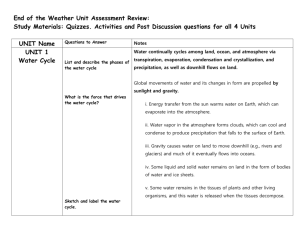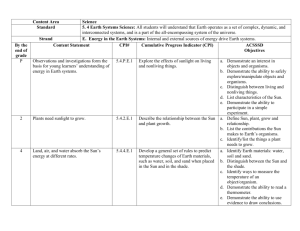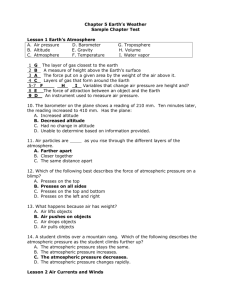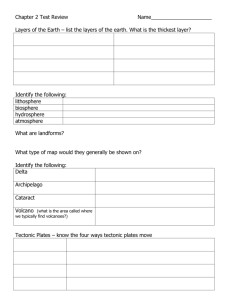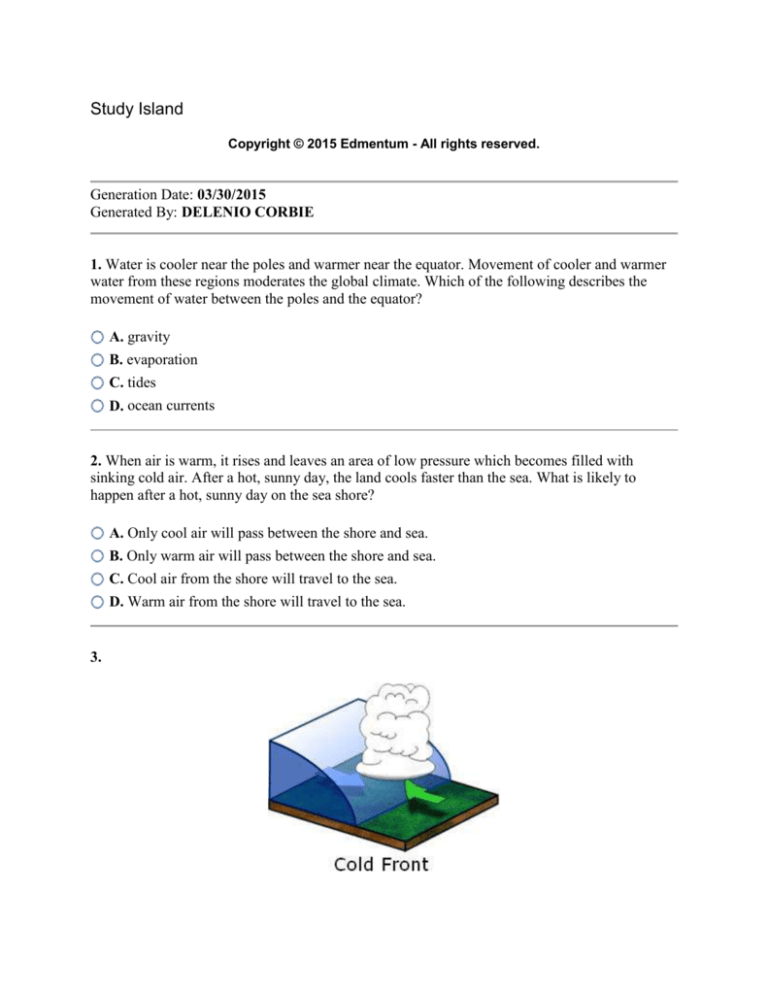
Study Island
Copyright © 2015 Edmentum - All rights reserved.
Generation Date: 03/30/2015
Generated By: DELENIO CORBIE
1. Water is cooler near the poles and warmer near the equator. Movement of cooler and warmer
water from these regions moderates the global climate. Which of the following describes the
movement of water between the poles and the equator?
A. gravity
B. evaporation
C. tides
D. ocean currents
2. When air is warm, it rises and leaves an area of low pressure which becomes filled with
sinking cold air. After a hot, sunny day, the land cools faster than the sea. What is likely to
happen after a hot, sunny day on the sea shore?
A. Only cool air will pass between the shore and sea.
B. Only warm air will pass between the shore and sea.
C. Cool air from the shore will travel to the sea.
D. Warm air from the shore will travel to the sea.
3.
When cold air moves under warm air, a cold front forms. The steep slope of the cold front tends
to suddenly push the warm air up and create vertical clouds. Given this information, which of the
following cloud types and weather conditions would most likely result from a fast moving cold
front?
A. cirrus clouds and snow
B. cumulonimbus clouds and thunderstorms
C. cumulus clouds and clear weather
D. stratus clouds and drizzly rain
4. An air mass that formed in a polar region is going to bring _______ weather.
A. dry
B. moist
C. cold
D. warm
5. Which of the following factors drives all the weather on Earth, including large-scale storms
and local weather systems?
A.
The Greenhouse Effect ensures that some of the Sun's heat will be trapped close to Earth.
The Sun heats up the air at different rates and the atmosphere must try to equalize
B. temperatures and pressures.
C.
D.
The ocean holds the heat of the Sun more efficiently than the land.
The Coriolis Effect curves the motion of wind due to the Earth's rotation.
6. Winds generally flow away from the equator and towards the poles. What transfer does this
flow of wind cause?
A.
B.
C.
a water transfer, with water moving from the ocean to the atmosphere
a water transfer, with water moving from the atmosphere to the ocean
an energy transfer, with heat energy moving toward the equator
D.
an energy transfer, with heat energy moving away from the equator
7. What is the original source of the energy that drives changes in the weather?
A. air temperature
B. ocean currents
C. the Earth's core
D. the Sun
8. Which of the following are major influences on weather and climate?
I. the cycling of water in and out of the atmosphere
II. the physical weathering of rocks and soil
III. uneven heating of the Earth by the Sun's energy
IV. global patterns of atmospheric movement
A. I, II, and III only
B. I, II, and IV only.
C. II, III, and IV only
D. I, III, and IV only
9. Weather is a condition of the atmosphere at a particular time and place. Wind, rain, and cloud
formations are all forms of weather phenomena. What is the primary source of energy for
weather phenomena?
A. tidal movements
B. magnetic fields
C. geothermal energy
D. solar radiation
10. Jennifer and Jamie have a class assignment to identify an example of climate change and an
example of a change in weather. They have come up with the following statements:
I. The average temperature in the United States has been rising over the past 25 years.
II. The temperature was warm on Monday but rainy and cold for the rest of the week.
III. The amount of snowfall has been decreasing over the past few years.
Which of the statements could be used as an example of a change in weather?
A. I only
B. II only
C. I and III only
D. all of these
11. Which property of oceans best explains why they have a major effect on climate?
A. They have a constant tidal movement.
B. They contain large amounts of dissolved salt.
C. They absorb gases from the atmosphere.
D. They hold a large amount of heat energy.
12. Which of these describes the main influence of jet streams on weather patterns?
A. Jet streams cause hurricanes to form over warm tropical waters.
B. Jet streams separate high pressure systems from low pressure systems.
C. Surface ocean water is pushed toward land by jet streams.
D. Weather systems, such as storms, steer along jet streams.
13. Sharon woke up on a sunny morning and ate breakfast. Then she looked outside and saw tall,
quickly-forming clouds. The clouds looked ready to rain. When she turned on the TV, she saw
just what she thought—a forecast for sudden rains. What most likely caused the change in
weather?
A. a cold front overtaking a warm air mass
B. a warm front overtaking a cold air mass
C. lack of wind
D. an expanding warm air mass
14. Part of the Sun's energy that reaches the Earth's surface is absorbed by land and water as
heat. The Earth's surface then releases heat back to the atmosphere.
Which of the following is true about this solar energy that is absorbed and released by Earth's
surface as heat?
Much of the heat is trapped at the top of Earth's atmosphere to protect Earth from
A. ultraviolet radiation.
Much of the heat is trapped low in the atmosphere and is a major factor in determining
B. Earth's climate.
C.
D.
All of this heat escapes the Earth's atmosphere, which keeps the planet cool.
All of this heat escapes the Earth's atmosphere, which keeps the planet hot.
15. Technology Enhanced Questions are not available in Word format.
16. Technology Enhanced Questions are not available in Word format.
17. Warm air expands and rises, creating an area of _________; cold air is dense and sinks to
create an area of ______________.
A. conduction, convection
B. low pressure, high pressure
C. high pressure, low pressure
D. convection, conduction
18.
There are lots of clouds, and it is storming very hard. There is a good possibility that tornadoes
could start forming.
What type of system is associated with the weather described above?
A. low pressure system
B. none of these
C. high pressure system
D. circulatory system
19. Tara goes to the beach during the summertime. One morning she wades into the ocean before
the Sun has risen and notices that the water in the ocean feels warmer than the sand on the beach.
In the afternoon of the same day, she wades back into the ocean and observes that now the water
in the ocean feels cooler than the sand on the beach.
Which of the following best explains the difference in temperature between the ocean and the
sand?
A.
B.
C.
D.
Water both heats up and cools down at a slower rate than land.
Water heats up at a faster rate than land, but cools down at a slower rate.
Water both heats up and cools down at a faster rate than land.
Water heats up at a slower rate than land, but cools down at a faster rate.
20.
Image modified from NOAA
The weather map above shows a zone of possible flash flooding in front of a cold front. If the
cold front continues to move toward the southeast,
the zone of possible flash flooding will enlarge to cover the entire United States.
A.
B.
no flash flooding will occur.
C.
D.
the zone of possible flash flooding will also move toward the southeast.
the zone of possible flash flooding will move toward the northeast.
21. The lower atmosphere is mostly warmed by radiated heat from Earth's surface. However,
water heats up and cools down more slowly than land. Knowing this, which of the following
statements is most likely true?
A.
On a sunny day, the air over a lake will be cooler than the air over the bordering land.
On a cloudy day, the air over a northern section of the ocean will be warmer than the air
B. over a southern section of the ocean.
On a cloudy day, the air over a southern section of the ocean will be warmer than the air
C. over a northern section of the ocean.
On a sunny day, the air over a piece of land will be cooler than the air over a bordering
D. lake.
22.
This image is courtesy of NOAA.
In the weather map above, there is a cold air mass overtaking a warm air mass in the central
portion of the U.S. This interaction is likely to cause severe thunderstorms. What type of
pressure system is associated with this interaction?
A. a high pressure system
B. a low pressure system
C. a mixed pressure system
D. a stationary pressure system
23. Due to the Earth's shape and orientation, areas near the equator receive the greatest amount of
energy from the Sun. Ocean currents
A.
B.
C.
D.
keep this energy concentrated in one region of the globe.
help to distribute this energy by warming other regions of the globe.
move only away from the equator as a result.
move only toward the equator as a result.
24. When you wake up before sunrise to take your dog for a walk on the beach, which of the
following conditions would you expect to be true?
A. The air over the water is hotter than the air over the land.
B. There will be no wind.
C. A morning shower that always occurs right by the ocean.
D. The air over the land is hotter than the air over the water.
25.
A jet stream is a belt of wind in the upper atmosphere that blows around the Earth from west to
east.
How is the jet stream related to the wind direction on the ground?
It can move air from the upper atmosphere to the lower atmosphere to bring circular
A.
winds.
B. It can slow down or speed up, causing wind on the ground to blow north or south.
C. When the jet stream blows from the west, the wind on the ground blows from the west.
D.
When the jet stream moves south, it moves its associated weather front, which causes
winds from the north.



